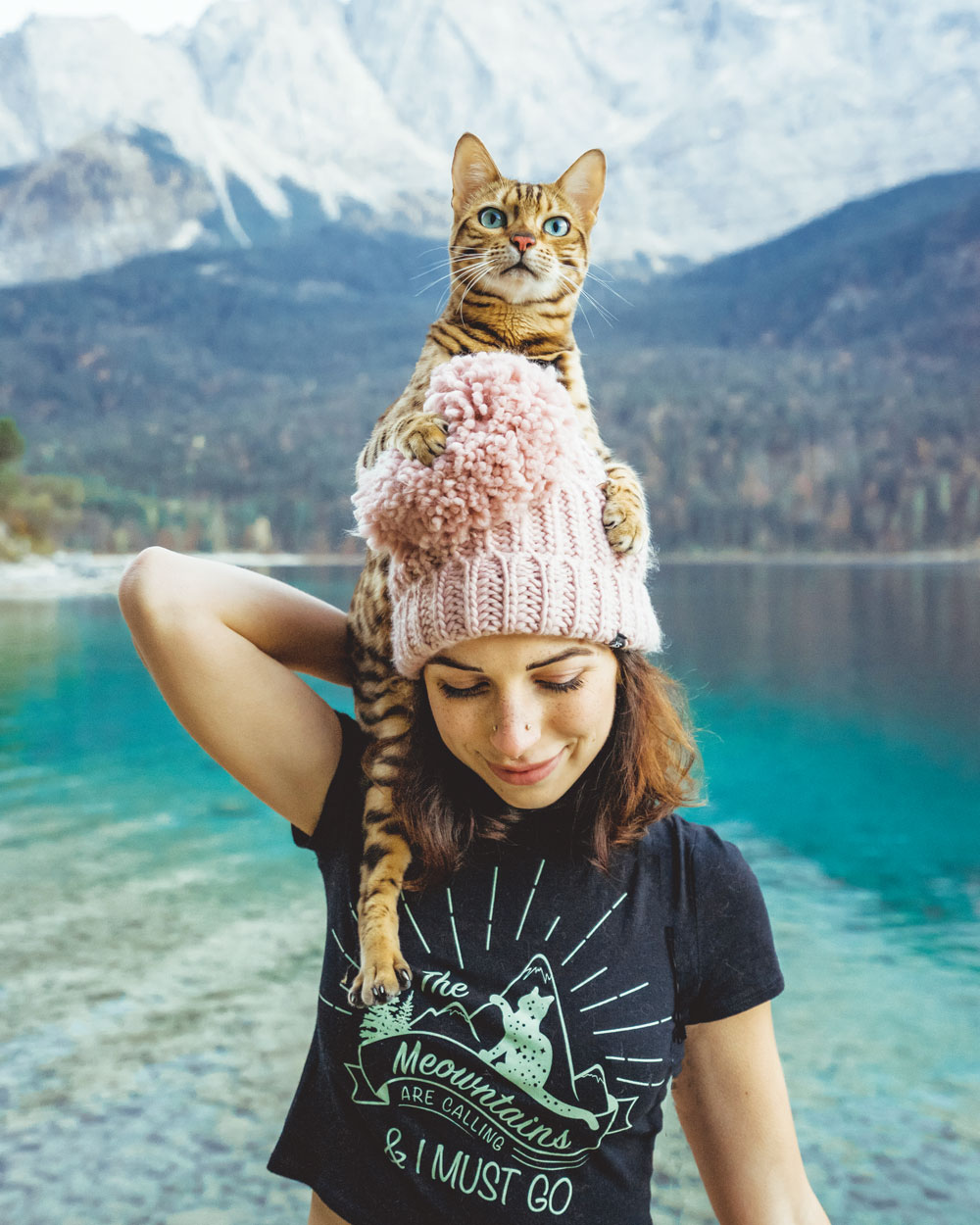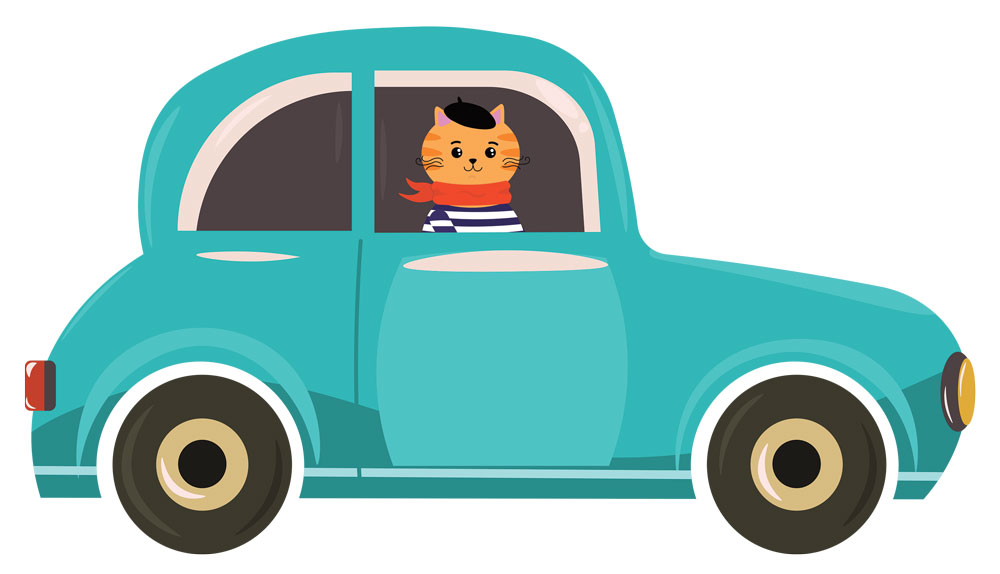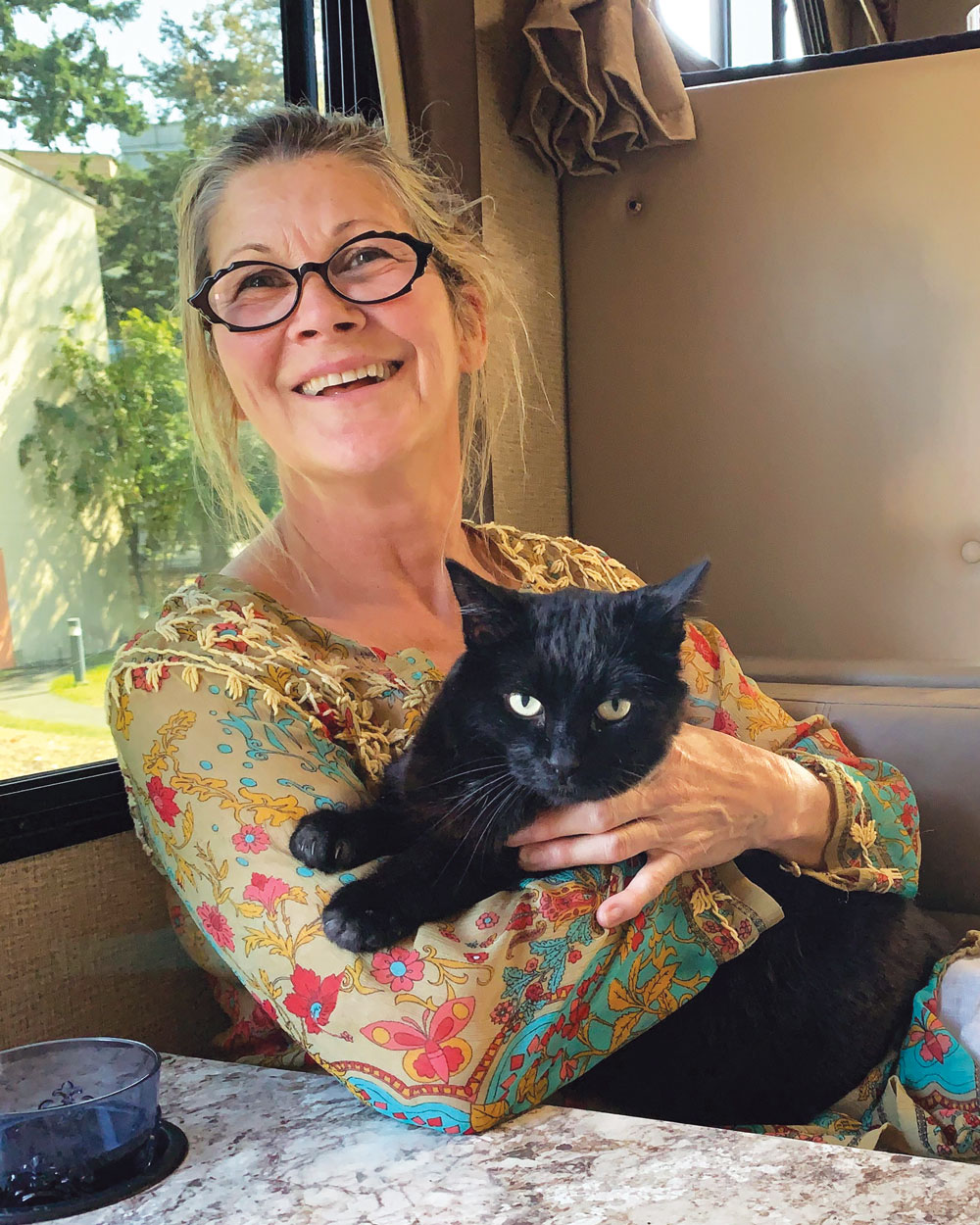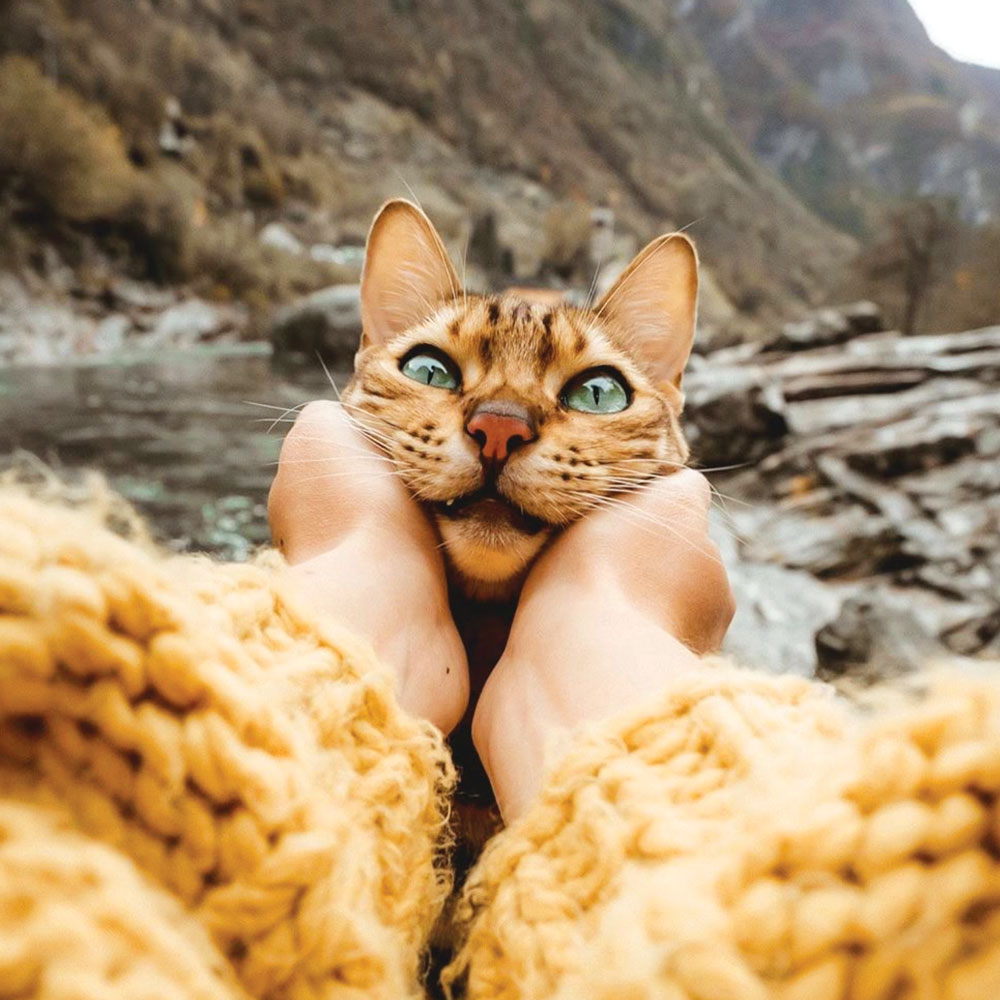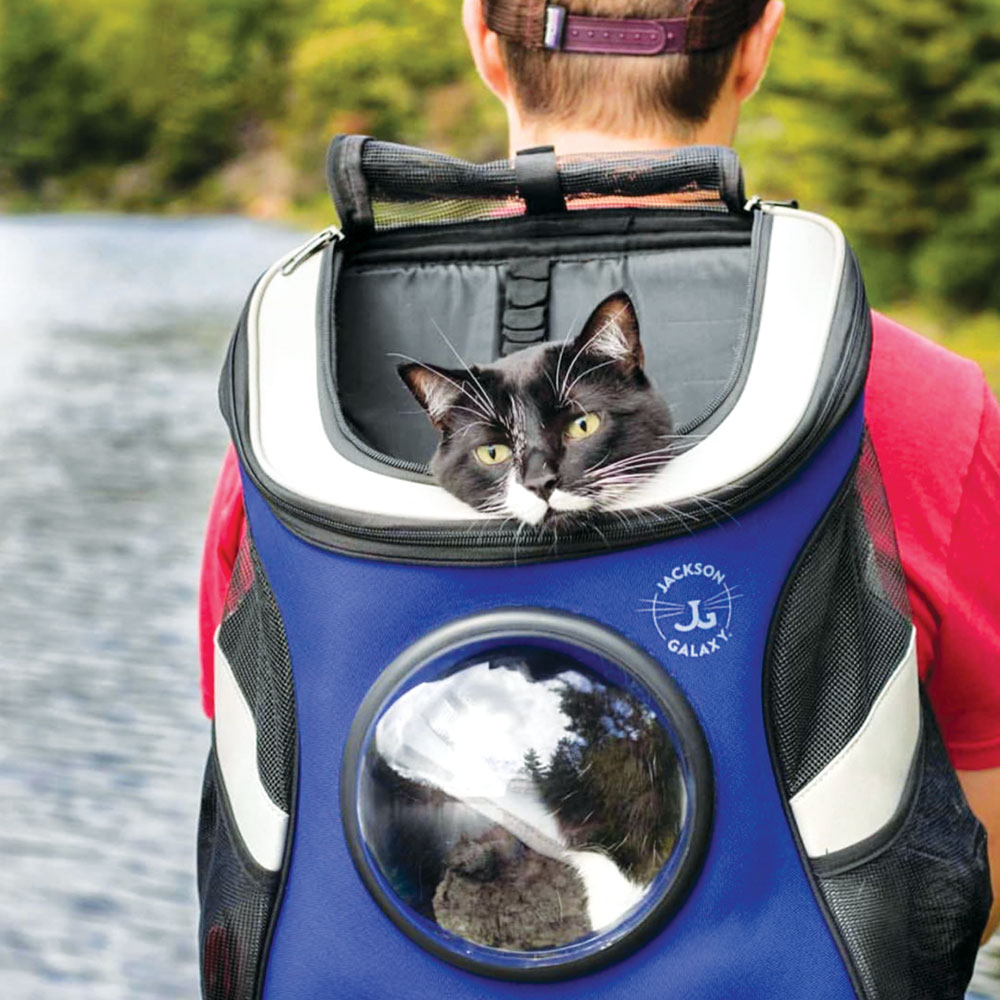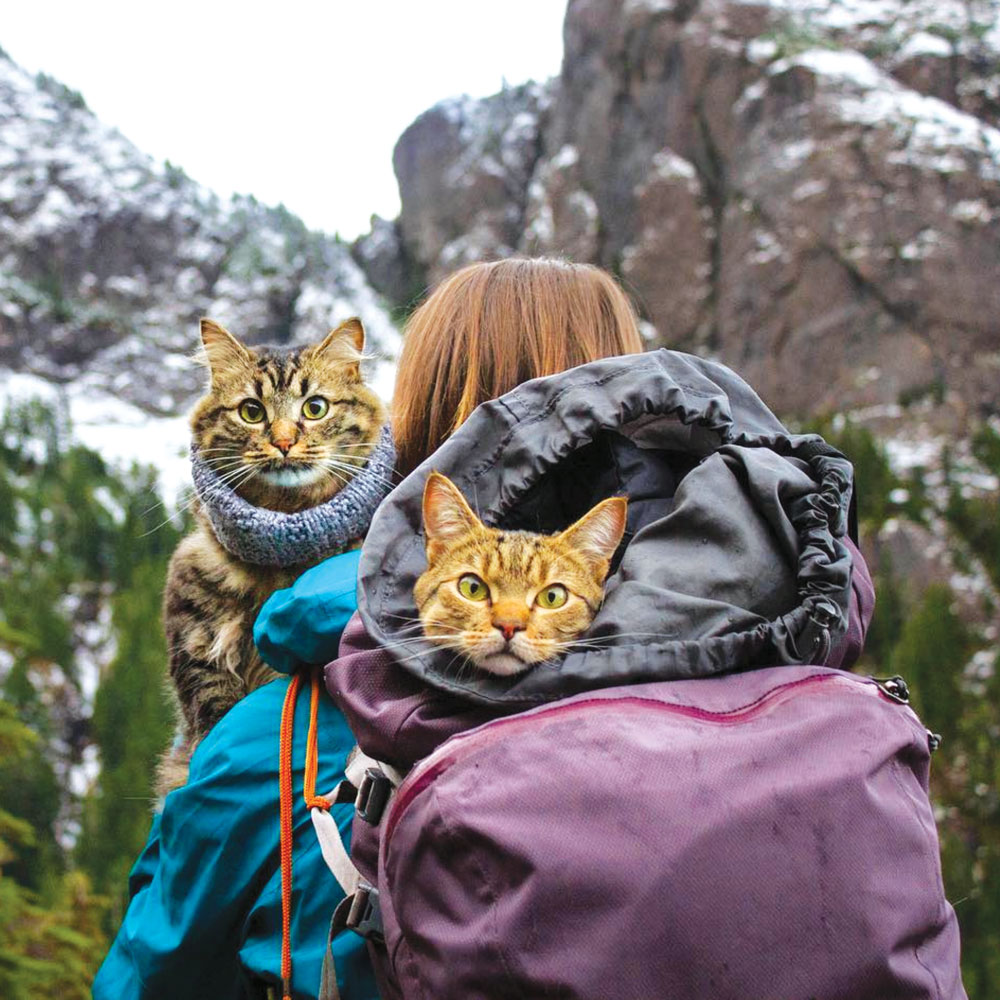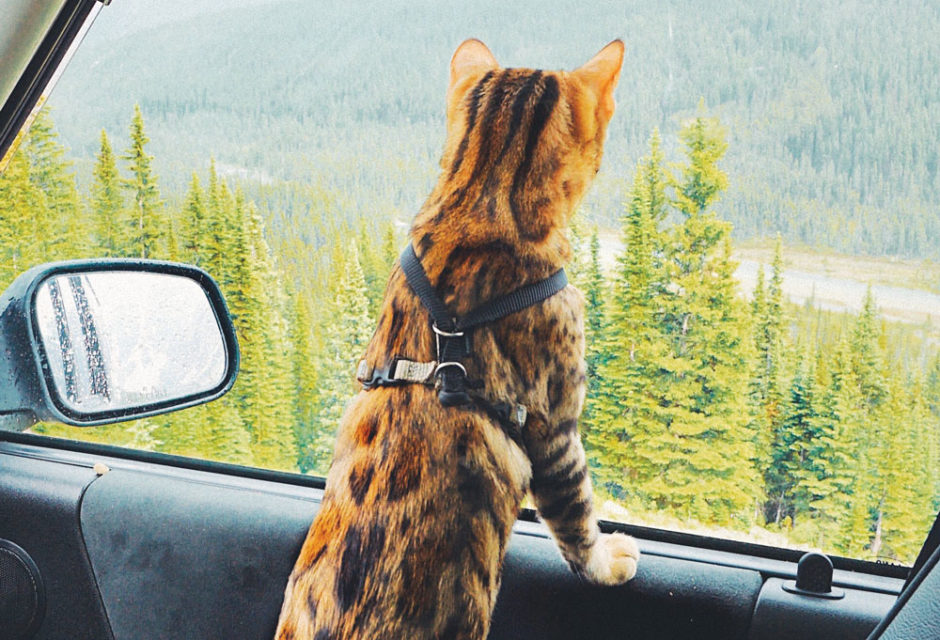
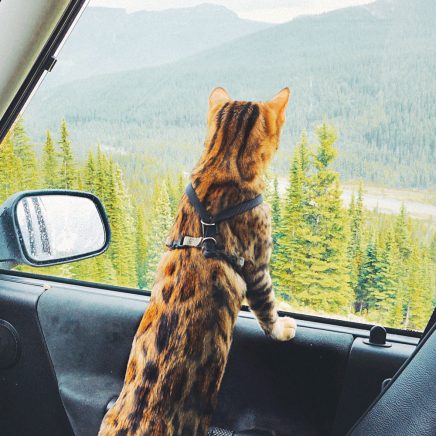
Have Cat, Will Travel!
Road tripping with your cat: tips and tales from the road
“People think I’m nuts because my cat Evelyn goes pretty much wherever I go,” says Joanne Hubert. “Evelyn is used to going outside—she is so smart and easygoing, but of course not all cats are created equal.”
Cats and road trips can be dicey—unless you plan ahead and have lots of patience. With the right preparation you can avoid heart-wrenching meows that reach ear-piercing and blood-curdling screams. It is possible to have a purring, happy travelling cat that sees the car as a gently moving playpen rather than a steel box hurtling down the highway of doom.
A carefully choreographed trip, mapping pit stops where you can leash kitty and walk her around is essential for her welfare, as well as yours and other drivers.
Not Planning Ahead
Generally, dogs are born travelers and love hanging their heads out the window, smelling the open road, while cats contain a bundle of neuroses ready to explode at the slightest change to their day. Any cat person knows they generally prefer the familiar: buying a different kind of cat food or moving the kitty litter box has the potential to derail, never mind putting them into a moving vehicle surrounded by unfamiliar sights and sounds.
I remember one road trip in gory detail, even though it happened decades ago. Windshield wipers on full speed, the miserable downpour outside wasn’t nearly as bad as the tornado inside. My sister and I were going camping and she insisted on taking Buster, her badass, semi-feral, 25-pound Tabby. Needless to say, we didn’t get too far on the highway with free-range Buster until we had to turn back. The upholstery was in shreds, as were our nerves. It was an accident waiting to happen. But it doesn’t have to be that way.
Suki Cat is one of the adventurous felines taking Instagram by storm—1.8 million followers and counting. Her adventure-partner Martina Gutfreund notes, “I think it is very important to highlight that we do not let Suki off leash! I often edit the harness and leash out in her photos for a cleaner image, but the only time Suki is off leash is when she is in our garden at home. Canadian national and provincial parks require by law that pets are on leash, and we completely agree with this for a number of reasons! There are plenty of predators in our neck of the woods that could easily have Suki as a snack, and it is also very important to make sure that your pet does not injure smaller wildlife since this is not your pet’s natural environment!”
Evelyn Rides Shotgun
“I had to train Evelyn to be a good traveller,” says Joanne. “She was a foster kitty, but you know how that goes—it was love at first sight.” Joanne works long hours in the film industry and wrote in her contract that Evelyn must come along. “I had a collar and a leash, and a little table on wheels so I could wheel her around the office—she was so tiny. Then I got her two apartment cat condos—one at home and one at the office—that gave Evelyn private and quiet time, which is so important for cats.” As well, Evelyn had a slew of people visiting her at work so she was very socialized.
There is a downside to Evelyn’s social skills—she likes other people’s vehicles, such as the telephone repair guy who left the back of his van open and Evelyn jumped in. “He was laughing and he also said it’s more common than people think. Pets get into workers’ trucks and drive away with them,” says Joanne. “And another cautionary tale: if you have visitors, make sure they don’t go home with kitty in their car.”
In the past ten years, Evelyn and Joanne have logged thousands of miles driving to and from work. “I know it was dangerous and wrong not to put her in a crate,” says Joanne. “She would lie flat across the dashboard of my Subaru for the 20-minute drive, to and from work. It took Evelyn a week before she was super-chillaxed in the car and knew the command ‘We are going to work.’ I’d put her harness on and she would wait at the front door.
“I believe that taking Evelyn to work gave her the smarts. And the more cats are left alone, the wilder they get. I also believe Evelyn is so clever because she was socialized as a kitten, not like the 13-year-old cat I adopted—he would not travel well.”
“Do as I say, not as I do”
Even though Joanne doesn’t put Evelyn in a crate (“she would scream bloody murder”) she does have some precautions in place, such as making sure the windows are never down (AC is always on) and having a proper leash.
Joanne recently traded in the Subaru for an RV because she plans on travelling across Canada with Evelyn and her three dogs. And Evelyn is attached to a six-foot leash when they aren’t driving. “An RV is like a house, and a lot of people live in RV’s with their cats,” adds Joanne. “Once we are rolling I take her off-leash so she can move around but she always stays in the cab over the driver’s seat. Having said that, most cats aren’t experienced travellers and I recommend crating kitty when driving.” At the risk of sounding really nuts, Joanne confesses that she bought the RV for Evelyn.
Step-by-Step Training
Before taking your cat on a road trip, Joanne advises (as do others) that you both drive around the block for a few minutes and for the next few weeks increase the time and distance, until kitty feels safe and not freaked out.
“I put Evelyn’s treats in the car, including her favourite pillow and blanket, catnip and a spray you can buy to calm and relax. Little tools help, but don’t just throw them in and expect it to happen: Patience is a virtue.”
Road Trip Prep
- Pack extra food and water, pet-safe cleaners, tethers, and toys.
- Map out your route to include rest areas where your fur baby can use the bathroom and have a short play time, stretch and stroll.
- Consider where you’ll use the bathroom as well. Reader Laura Riddle recommends stopping at pet stores to use the bathroom as you can bring your pets inside with you; a genius tip. Never leave your cat or other pets alone in a hot car.
- Consider disposable litter trays or opt for scooping and bagging.
- When choosing a safety-tested crate, make sure it’s big enough so your cat can stand up, lie down and turn around. But if the crate is too big, kitty can get bashed around.
- The BC SPCA recommends “airline type” (not cardboard) cat travel carriers to keep your cat safe. A sturdier carrier provides greater protection and security for your cat, and it will protect your cat from escaping and from injury in the event of a crash.
- It must be well vented for plenty of air. And make sure the crate is secured to your car through proper vehicle straps.
- If you hate a crate, make sure a harness and tether is snugly fastened and your cat cannot roam around the car.
- Crate or not, turn off power windows. Cats are escape artists.
- Never let kitty sit on your lap. In case of an accident, there is a risk of being injured from the airbag, not to mention going through the front windshield.
The Law and Driving with Pets—Buckle Up!
Pet travel is on the rise: 85 million U.S. families own a pet, a 56 percent increase from 10 years ago. Although 37 percent of pet owners travel with their pets every year, less than 20 percent of pet owners buckle up their furry companions when they travel, according to a 2017–2018 National Pet Owners Survey conducted by the American Pet Products Association.
With this growing trend, pet car restraint laws are being considered. For instance, some U.S. states require pets in moving vehicles to be secured in a carrier or wear a seat belt. Failure to comply can result in a fine of $250 to $1000. In Arizona, for example, if you drive with an animal on your lap or if a police officer determines your transportation method creates an unsafe situation, you can be charged under distracted driving laws.
In Ontario, Canada, pets don’t need to be belted or restrained in motor vehicles. The Highway Traffic Act, however, states that the motorist may be charged with crowding the driver’s seat if a pet is interfering with the driver’s safe control of the automobile.
Most every city has its own bylaws regarding leashes and restraints that you must follow precisely, so do some research before hitting the road. For instance, the province of Ontario bylaw states that:
» Cats needs to be placed in a carrier or a crate and then the carrier/crate needs to be secured.
» No animals on the driver’s lap. Animals should be in the back seat secured by a crate or seatbelt harness.
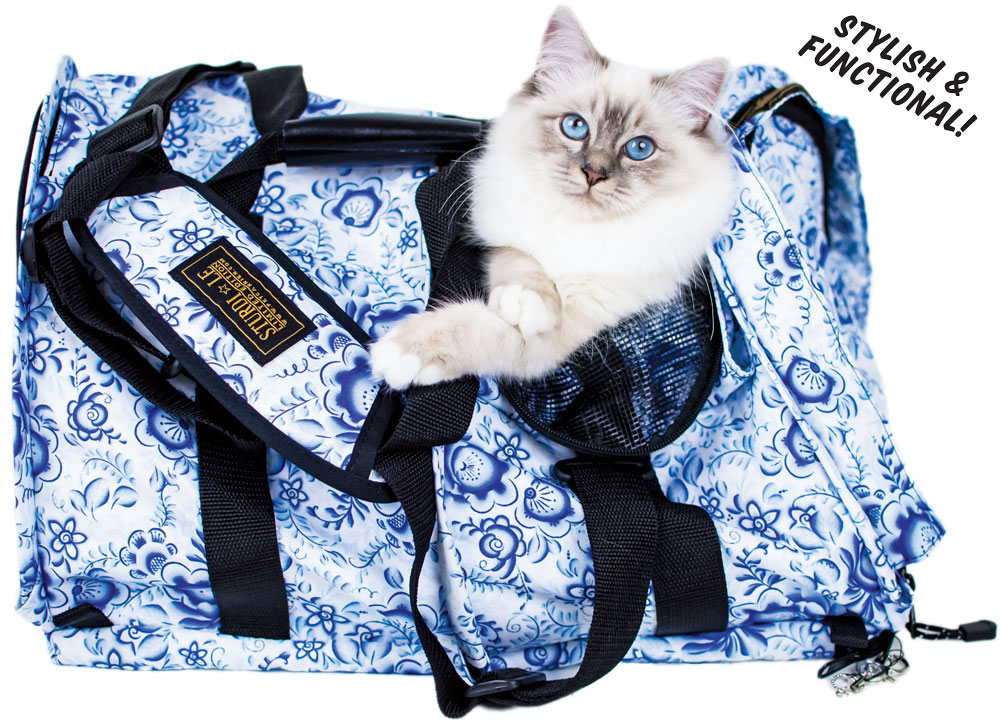
Even with kitty in a crate, you must never leave an animal alone in your vehicle—even five minutes with the windows cracked can cause heatstroke. If you leave your animal unattended, in Canada you could potentially be charged under the Criminal Code of Canada and the provincial SPCA Act.
Always keep in mind that having an unrestrained kitty in the car means a distracted driver and an increased risk of an accident that could injure you, your pet, and anyone else involved.
Besides possible injuries and fines there could be devastating financial consequences. Your insurance company may deny your claim if you did something that caused an accident. So make sure everyone is buckled up and comes home safe and sound.
Joanne Hubert and her cat Evelyn
Tales from the Road
When my big white cat was a kitten, he came with me everywhere. Fritz jumped in the truck, sat shotgun, and we traveled all over B.C. Fast forward 25 years and we drive everywhere with Halliday, a tiny Abyssian Blue. Although she wears a Supergirl jacket and loves walking on her leash—I put on my coat when on she’s at the door—Halliday isn’t a good traveler and meows constantly.
On long distance car trips she also wears a halter and leash and sits in a big soft crate with a metal frame and netting so she can see out. This makes her safe and not very happy but she settles down and cheers up after a few days. It takes an animal time to get used to anything. Years ago, my three cats sat on the front seat on my lap and looked out the car window—I know that’s dangerous and I highly recommend a crate.—June Pretzer
I had a cat that went wherever I did, including to my parents when I got married. The day after, we started for home. On the way, Chlöe began howling like mad in her carrier so I rummaged around for the stuffed bunny she liked to sleep with. I let her out for a quick moment, hoping to check her over but I never got the chance. Somehow, she managed to step on our leftover wedding cake, sinking up to her chest with both front paws. Do you think I could catch her to return her to her carrier? She managed to leave cake pawprints on absolutely everything we were bringing back, including luggage, wedding gifts, and rented suits. Icing pawprints ended up on all four headrests, us, and even the dashboard where I managed to recapture her but by then, our car was destined to smell like a bakery until we sold it a year later. The cake, well, it looked like Swiss cheese by then. Once she was back in her carrier, she curled up and went right to sleep. So cat typical!!!—Victoria Milley
Little Kitty loved road trips and boat trips. He lived in a sailboat, Jeep, and RV. Nothing seemed to phase him and he was always on deck or at a window, enjoying the scenery. Cat boxes were a challenge but he never had an accident.—Debra Miller
Looking For Cat-Travel Inspiration? Follow These Instagram Accounts!
@sukiicat Stunning photos of Suki the Bengal cat’s outdoor adventures will give you serious wanderlust.
@adventurecatsorg Photos of cats who enjoy adventure may inspire you to hit the road with your cat.
@boltandkeel From kayaking trips to van life, these adventurous feline brothers are living their best lives and sharing gorgeous photos along the way.
Join the newsletter and never miss out on cat content again!
"*" indicates required fields
By clicking the arrow, you agree to our web Terms of Use and Privacy & Cookie Policy. Easy unsubscribe links are provided in every email.





